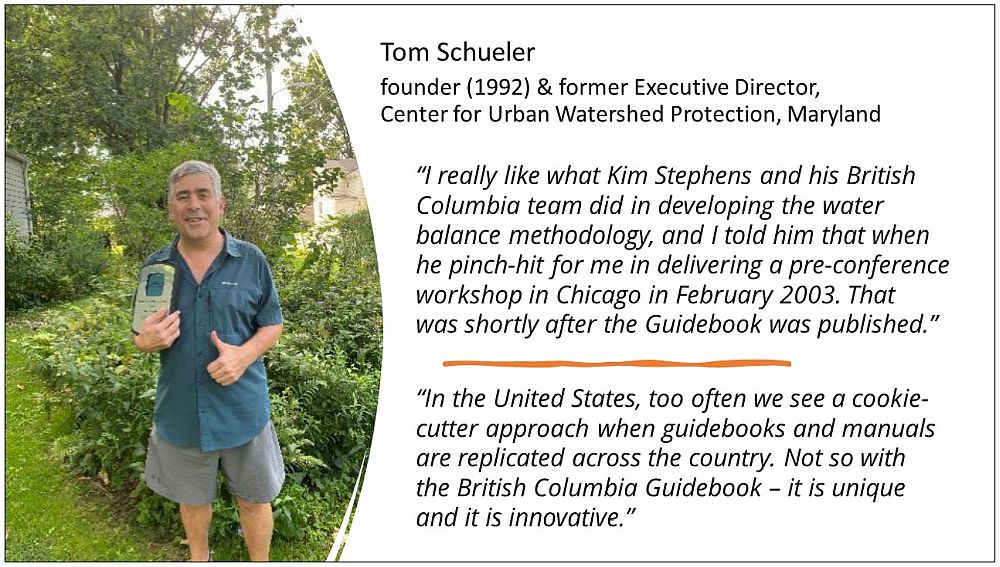Introducing the Water Balance Model to Ontario

Making It Work: Credit River Water Management Strategy
For over half a century Credit Valley Conservation has worked in the Credit River Watershed to minimize drought and flooding, improve water quality, support socially and economically viable communities, protect natural features and green spaces, and restore damaged ecosystems. In June 2006, Credit Valley Conservation and the US-based Center for Watershed Protection held an interactive 4-day workshop titled Making It Work: Credit River Water Management Strategy, and dealing with innovative sustainable management techniques that can be implemented in the Credit River watershed.
Featured presenters included Cate Soroczan of Canada Mortgage & Housing Corporation, Tom Schueler of the Center for Watershed Protection. The workshop provided an opportunity to provide knowledge-transfer related to experience and lessons learned in other jurisdictions, including British Columbia. Cate Soroczan made a presentation on the Water Balance Model for Canada
Water Balance Model for Canada
Developed by a BC-based Inter-Governmental Partnership as an extension of Stormwater Planning: A Guidebook for British Columbia, the Water Balance Model for Canada (WBM) enables users to compare scenarios for rainwater runoff volume reduction in order to achieve a light ‘hydrologic footprint’. The Partnership comprises a consortium of local, regional, provincial and federal agencies.
Schueler, co-founder of the Center for Watershed Protection, has praised the British Columbia Guidebook because of its innovation. “I really like what Kim Stephens and his British Columbia team did in developing the water balance methodology, and I told him that when he pinch-hit for me in delivering a pre-conference workshop in Chicago in February 2003. That was shortly after the Guidebook was published. In the United States, too often we see a cookie-cutter approach when guidebooks and manuals are replicated across the country. Not so with the British Columbia Guidebook – it is unique and it is innovative.”
According to Soroczan, “The early success of the WBM in British Columbia, particularly in promoting an understanding of how to improve the built environment and protect the natural environment, generated interest in expanding the focus of the tool to reach a national audience. This early success led to the decision by Environment Canada, Canada Mortgage & Housing Corporation (CMHC) and the Province of British Columbia to join forces to create a truly national Water Balance Model for Canada.”
“To date, the structure and content placeholders for provincial rainwater management communities-of-interest have been created for five provinces: British Columbia, Alberta, Manitoba, Ontario and Nova Scotia”, added Soroczan. To view her presentation, click on Water Balance Model for Ontario
Credit Valley Conservation History:
Credit Valley Conservation (CVC) was formed in May 1954 and has been working for over 50 years to protect the natural environment. CVC is one of 36 conservation authorities operating in Ontario, and is a partnership of the municipalities within the Credit River Watershed. CVC is a community-based environmental organization originally formed by an Act of provincial government and dedicated to conserving, restoring, developing and managing natural resources on a watershed basis.
The Credit River watershed is in one of the most rapidly urbanizing parts of Canada, adjacent to the Greater Toronto area and includes parts of the municipalities of Mississauga and Brampton. The river’s headwaters are located above the Niagara Escarpment, a World Biosphere Reserve, and are the source of four rivers, the Credit, Humber, Etobicoke and Nottawasaga. A small section of the Oak Ridges Moraine, as well as a number of other moraines are located within the watershed’s boundaries.
In June 2006, the Credit River Water Management Strategy Update (CRWMSU) was completed by CVC in working partnerships with municipalities, provincial agencies, academics and individual groups. The CRWMSU found that existing watershed conditions show some degradation in the environment, and that current planning and development practices are not sustainable. The CRWMSU found that growth can occur in a sustainable manner if we implement a number of sustainable practices to treat runoff. CVC is moving into the implementation phase of this strategy and at this time would like to gather watershed stakeholders and government representatives to discuss innovative approaches to creating a healthy future for the watershed. To download a brochure, click on Credit Valley Water Management Strategy Update
With expertise in planning, ecology, biology, hydrogeology and water resources engineering, CVC staff monitor the health of the watershed and develop programs to protect and enhance its resources.

